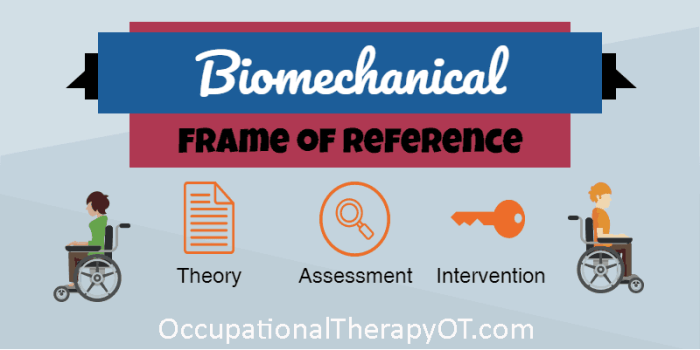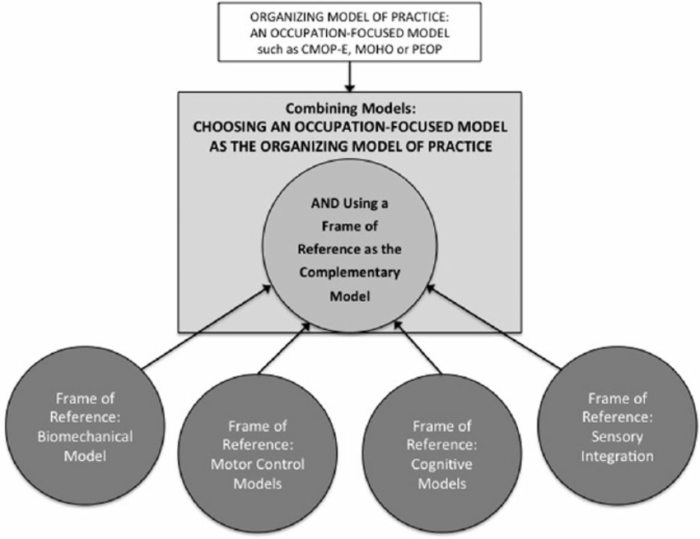Biomechanical model in occupational therapy – Biomechanical models have emerged as indispensable tools in occupational therapy, offering a comprehensive framework for understanding and improving human movement. These models provide a detailed representation of the musculoskeletal system, including joints, muscles, and external forces, enabling therapists to analyze movement patterns, identify impairments, and design targeted interventions to enhance function and well-being.
The components of biomechanical models, their interactions, and applications in occupational therapy practice will be explored in this comprehensive overview.
Introduction

Biomechanical models are valuable tools in occupational therapy, providing insights into the mechanics of human movement and musculoskeletal function. They help therapists assess movement patterns, identify musculoskeletal impairments, and design interventions to improve movement and function.
Biomechanical models are used in a variety of settings, including:
- Assessing movement patterns and identifying musculoskeletal impairments in individuals with disabilities
- Designing interventions to improve movement and function in individuals with musculoskeletal disorders
- Evaluating the effectiveness of occupational therapy interventions
Components of Biomechanical Models
Biomechanical models typically include the following components:
- Musculoskeletal system:The bones, muscles, joints, and ligaments that make up the body’s framework
- Joints:The points where two or more bones meet
- Muscles:The tissues that contract to produce movement
- External forces:The forces that act on the body from outside, such as gravity and friction
These components interact to create movement. Muscles contract to pull on bones, which causes the joints to move. External forces, such as gravity and friction, can also affect movement.
Applications of Biomechanical Models

Biomechanical models are used in a variety of applications in occupational therapy, including:
- Assessing movement patterns:Biomechanical models can be used to analyze movement patterns and identify any deviations from normal. This information can be used to diagnose musculoskeletal impairments and develop treatment plans.
- Identifying musculoskeletal impairments:Biomechanical models can be used to identify the specific muscles or joints that are impaired. This information can be used to develop targeted interventions to address the impairments.
- Designing interventions:Biomechanical models can be used to design interventions that are tailored to the individual’s specific needs. These interventions may include exercises, assistive devices, or modifications to the environment.
- Evaluating the effectiveness of interventions:Biomechanical models can be used to evaluate the effectiveness of occupational therapy interventions. This information can be used to make adjustments to the intervention plan as needed.
Limitations and Future Directions: Biomechanical Model In Occupational Therapy

Biomechanical models are a valuable tool in occupational therapy, but they also have some limitations. These limitations include:
- Complexity:Biomechanical models can be complex and difficult to understand. This can make it challenging for therapists to use them effectively.
- Cost:Biomechanical models can be expensive to purchase and use. This can limit their availability to therapists.
- Accuracy:Biomechanical models are not always accurate. This can be due to a variety of factors, such as the complexity of the model and the quality of the data that is used to create the model.
Despite these limitations, biomechanical models are a valuable tool in occupational therapy. They can provide therapists with insights into the mechanics of human movement and musculoskeletal function. This information can be used to assess movement patterns, identify musculoskeletal impairments, and design interventions to improve movement and function.
As research continues, the limitations of biomechanical models are likely to be overcome. This will make them an even more valuable tool in occupational therapy.
FAQ
What are the limitations of using biomechanical models in occupational therapy?
Biomechanical models are simplified representations of the complex human body, and their accuracy can be limited by factors such as individual variability, soft tissue properties, and the dynamic nature of movement.
How can biomechanical models be used to improve patient outcomes?
By providing a detailed analysis of movement patterns and musculoskeletal impairments, biomechanical models can guide the development of tailored interventions that target specific areas of dysfunction, ultimately improving patient function and reducing pain.
What are some emerging trends in the use of biomechanical models in occupational therapy?
Emerging trends include the integration of advanced motion capture systems, machine learning algorithms, and virtual reality simulations to enhance the accuracy and utility of biomechanical models in occupational therapy practice.